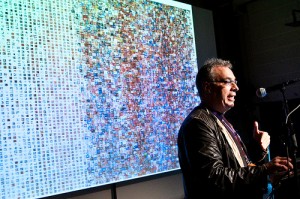If the strongest point of the N. Katherine Hayles’ seminar was her superb framing of the theoretical issues, the strongest aspect of Lev Manovich’s talk was that it seemed to gain more and more momentum as time went on. Which is to also say, Manovich got into the swing of things a tad more slowly. Indeed, as he was being introduced he made last minute amendments to his presentation. And the whole set up was rather punk – no PowerPoint here friends, though plenty of computation.

Lev Manovich discusses one of his visualizations. Not at the seminar I'm recounting, mind you, but hopefully you get the idea.
Manovich’s point, which by the end I was actually quite convinced by, was that using visualizations like these provides a unique way to observe ‘patterns’. Manovich wasn’t saying such visualizations provide access to some deep meaning or understanding, but rather, that visual patterns are a rather interesting way to open up questions for further exploration (e.g. seeing a pattern in Time magazine covers during a certain period, and then further exploring what transformations might have been taking place). What I liked so much about the talk was how it seemed to rub so uncomfortably against the cherished approaches of much of the arts and humanities. Indeed, once questions rolled around, there were pressing questions directed at Manovich; accusations, for example, that he was wrongly proposing, even promoting, ‘generalisation’. And I loved his eventual answer to these charges: “so!?” His point, as I understood it, was that at the level of pointing to patterns, visualizations are no more a generalisation than Deleuze’s writings from the 1960s (which might also be used in the lead up to a deeper understanding of some particular cultural artefact in the present). And that is an interesting thought.
[…] This event was a bouble bill, of course – follow the link for a short blurb around Lev Manovich’s talk. […]